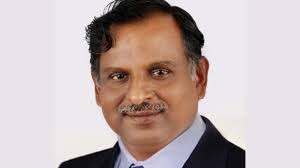Meet Isro’s New Chief Dr V Narayanan: The Rocket Man who made India’s Moon Dreams Possible
Reference: GS 3 – Achievements of Indians in science & technology; indigenization of technology and developing new technology; Awareness in the fields of IT, Space.
Why in the News?
- V Narayanan, currently serving as the Director of the Liquid Propulsion Systems Centre (LPSC), Thiruvananthapuram, has been appointed as the next Chairperson of the Indian Space Research Organisation (ISRO).
- Alongside heading ISRO, Dr. Narayanan will also serve as the Secretary of the Department of Space.
- Narayanan will succeed Dr. S Somanath, the incumbent ISRO Chief, on January 14.
- The Appointments Committee of the Cabinet issued the official order confirming this appointment on Tuesday.
DR. V NARAYANAN
His Contributions and Achievements
- Career Overview: Began his career at ISRO in 1984 and played a pivotal role in developing technologies for modern launch vehicles, including the PSLV and LVM3.
- Key Contributions:
- Worked on solid propellant-based engines for the Augmented Satellite Launch Vehicle (ASLV) during his early career.
- Pursued an MTech in cryogenic engineering from IIT-Kharagpur.
- Among the first scientists at ISRO to work on cryogenic engines, contributing significantly to India’s capability to build these advanced engines.
Role at LPSC:
- As Director of the Liquid Propulsion Systems Centre (LPSC), he has led the development of the Next Generation Launch Vehicle (NGLV).
- NGLV is envisioned as a heavier rocket capable of carrying 30 tonnes to low Earth orbit, essential for India’s ambitions to establish a space station and conduct manned lunar missions.
- Oversaw advancements in launch vehicles, including the LVM3, which is set to carry astronauts for the Gaganyaan mission.
- Notable Achievement: Played a foundational role in the successful development of India’s cryogenic engine technology through research and experimental studies.
Cryogenic Technology Development:
- India initially aimed to acquire cryogenic propulsion technology from Russia, but geopolitical challenges led to the decision to develop it indigenously.
- As Project Director, Dr. Narayanan and his team conceived, designed, and developed India’s cryogenic propulsion systems, which are now integral to the LVM3 rocket.
- This achievement made India the sixth country globally to master cryogenic technology.
LVM3 Development and Achievements:
- His team not only developed the cryogenic engine but also ensured its swift induction and operationalisation in the LVM3 launch vehicle.
- LVM3’s first operational mission successfully launched the Chandrayaan-2 mission.
Leadership in Chandrayaan Missions:
- Chaired the National Expert Committee to investigate the hard landing of Chandrayaan-2. The committee identified issues and implemented corrective measures.
- These improvements were incorporated into Chandrayaan-3, which achieved a successful soft landing in August 2023, making India the fourth nation to accomplish this milestone.
Contribution to Gaganyaan:
- Under his leadership, the Liquid Propulsion Systems Centre (LPSC) has been working on propulsion systems for the crew and service modules of the Gaganyaan mission.
Way Forward for ISRO under Dr. V Narayanan
Advancing Space Exploration Missions:
- Human Spaceflight: Successfully execute the Gaganyaan mission, marking India’s first crewed space mission, and laying the foundation for future human space exploration.
- Lunar and Planetary Missions: Build on the success of Chandrayaan-3 with advanced lunar exploration and initiate planetary missions to Mars and Venus.
Development of Next-Generation Launch Vehicles (NGLV):
- Prioritise the development of the NGLV with enhanced payload capacities to support India’s long-term goals of a space station and manned lunar missions.
- Focus on reusable and cost-efficient launch vehicle technologies to compete globally in the satellite launch market.
Establishing India’s Space Station:
- Progress plans for setting up India’s own space station, leveraging ISRO’s expertise in propulsion systems and spacecraft technology.
Enhancing Indigenous Capabilities:
- Strengthen indigenous satellite-building capabilities for communication, navigation, and Earth observation to meet national demands.
- Expand research and development in advanced propulsion systems, including electric and hybrid technologies.
Strengthening Commercial Space Ventures:
- Boost the role of NSIL (NewSpace India Limited) and IN-SPACe (Indian National Space Promotion and Authorization Center) in promoting private sector participation.
- Position India as a leader in the global satellite launch market by leveraging cost advantages and reliability.
Fostering International Collaboration:
- Collaborate with global space agencies for joint missions, technology sharing, and deep-space exploration.
- Play a pivotal role in international initiatives like asteroid defense and climate monitoring.
Focus on Research and Innovation:
- Encourage academic and industrial partnerships to innovate in space technologies, materials, and processes.
- Invest in emerging fields like quantum communication, artificial intelligence in space systems, and space-based solar power.
Ensuring Sustainability in Space:
- Develop technologies for debris management and promote sustainable practices in satellite and launch vehicle operations.
- Advocate for global space governance to ensure equitable and responsible use of outer space.
Mains question
Discuss the challenges and opportunities for ISRO focusing on indigenous technology development and advancing India’s space exploration and commercial ambitions. (250 words)




